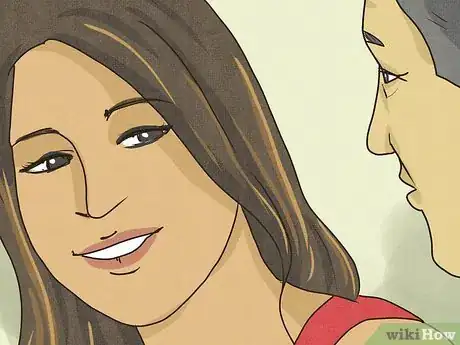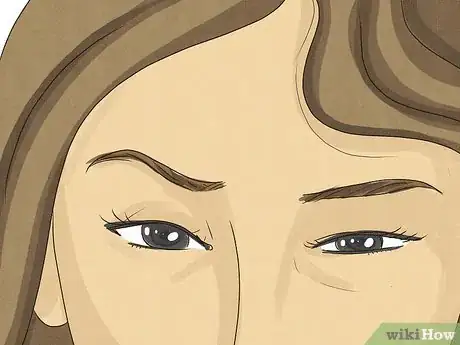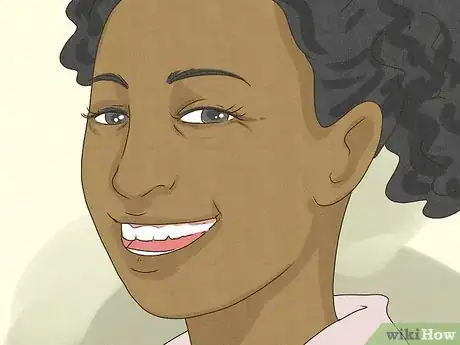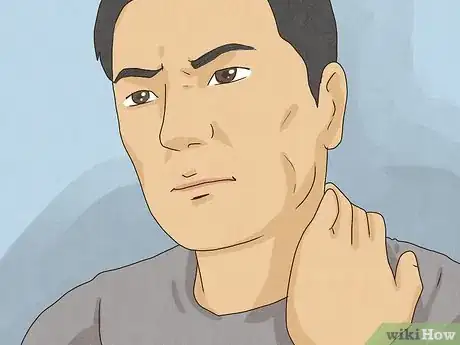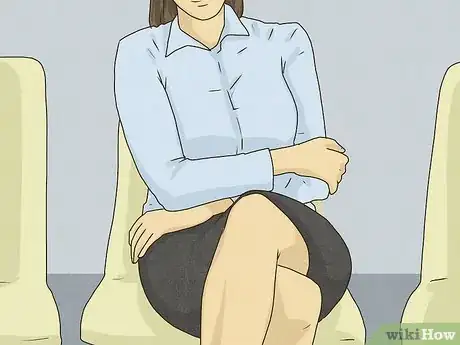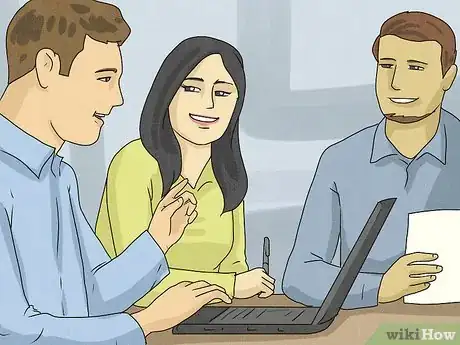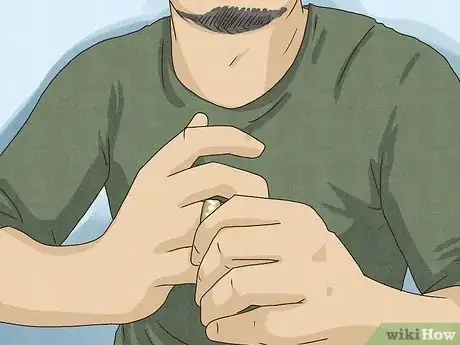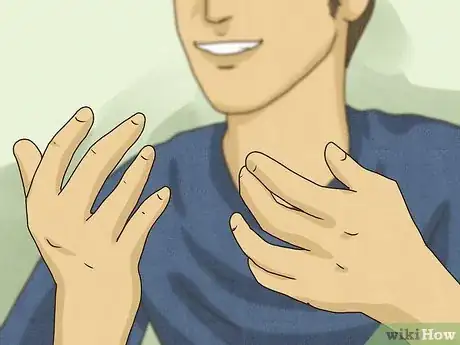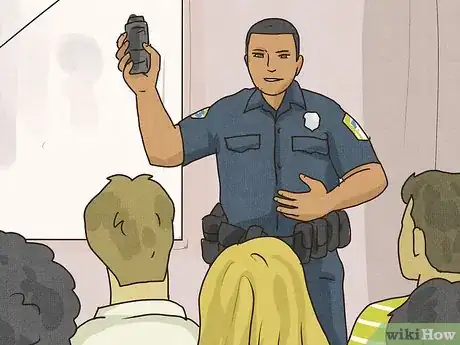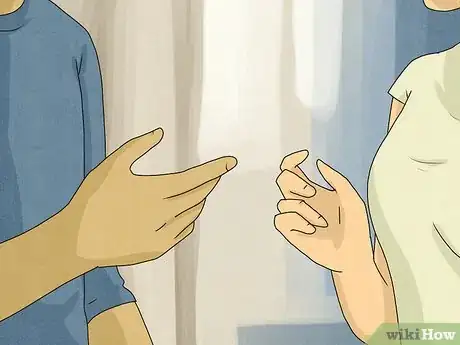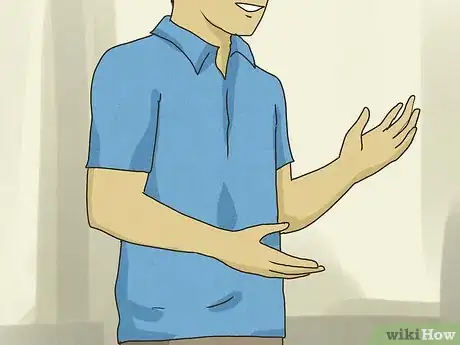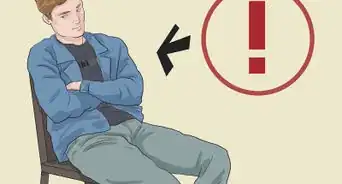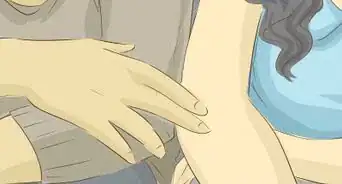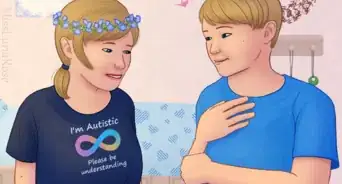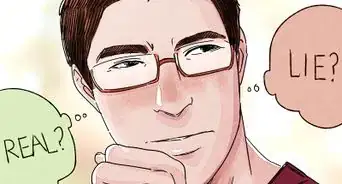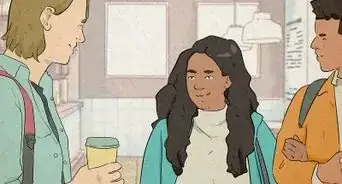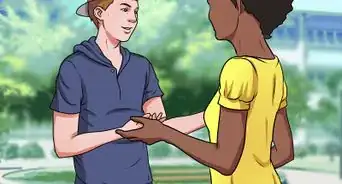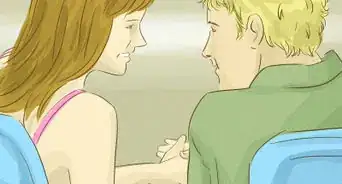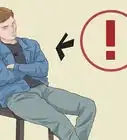This article was co-authored by Cher Gopman. Cher Gopman is the Founder of NYC Wingwoman LLC, a date coaching service based in New York City. 'NYC Wingwoman' offers matchmaking, wingwoman services, 1-on-1 Coaching, and intensive weekend bootcamps. Cher is a Certified Life Coach, a former psychiatric nurse, and her work has been featured on Inside Edition, Fox, ABC, VH1, and The New York Post.
There are 11 references cited in this article, which can be found at the bottom of the page.
wikiHow marks an article as reader-approved once it receives enough positive feedback. This article received 34 testimonials and 94% of readers who voted found it helpful, earning it our reader-approved status.
This article has been viewed 6,823,370 times.
Reading body language, or non-verbal cues, is a way to infer things about people you see around you or have interactions with. When you know how to do it, reading body language can tell you a lot about someone's feelings, mental state, or what they really mean when they’re speaking (especially if they’re lying). Understanding non-verbal communication can even help you connect better with people and build better relationships, so take some notes!
Steps
Facial Cues
-
1Eye contact: Is the person staring at you intensely or does the eye contact feel just right? If someone is making an uncomfortable amount of eye contact while you’re talking, it could be a sign that they are lying. If their level of eye contact feels normal, they are probably just paying attention to what you’re saying or really into the conversation you’re having. They might even be into you romantically![1]
- Eye contact norms are different across cultures. In some cultures, it's considered rude.[2] It can also feel too intense for people with disabilities or mental health issues, e.g. autism or social anxiety. So in some cases, avoidance of eye contact just means that the person is trying to stay comfortable or be polite.
- When in doubt, trust your instincts when it comes to reading body language. Though there are many general ways to read non-verbal cues like eye contact, everyone is different, so go with your gut instinct.
-
2Raised eyebrows: Raised eyebrows are another common facial cue that someone is feeling uncomfortable. Worry, surprise, and fear are all types of discomfort, so when someone raises their eyebrows, they might be feeling any of these emotions.[3]
- Raised eyebrows can also be a sign of insincerity. For example, if someone compliments your outfit with their eyebrows raised, they might not really mean it.
- Other times, people may raise their eyebrows when they feel curious.
Advertisement -
3Crow’s feet: When a smile is genuine, the corners of their eyes crinkle. When someone is forcing a fake smile, these crow’s feet don’t appear. Eyes don’t lie![4]
- Look at a posed photo where everyone’s smiling on command to get an idea of what it looks like when smiles are forced.
-
4Clenched jaw and furrowed brow: Together, these are often an indication that someone is feeling stressed or worried. People often tighten their neck along with their jaw and their brow, so they might rub their neck involuntarily when they’re stressed, too.[5]
- For example, if you’re a manager and you ask a subordinate to work over the weekend, a clenched jaw and furrowed brow might show you that the proposal stresses them out. You might want to reconsider asking them to do you the favor!
-
5Grimacing: Grimacing is when someone’s muscles around the mouth start pulling back. This kind of grimacing reaction can show you that someone is panicking or feeling uncomfortable inside. Many facial cues such as this, known as microexpressions, are involuntary, so you can tell the truth about how someone is really feeling by observing them.[6]
- People may also show microexpressions of discomfort or fear when they’re lying. So, be wary if someone starts grimacing when they’re telling you something!
Gestures
-
1Crossed arms and legs: In a conversation or a meeting, these non-verbal cues can often indicate resistance to your ideas. Many people do this involuntarily, which is a symbol of being mentally, physically, and emotionally blocked off from someone.[7] It could also mean that a person feels insecure or guarded.
- For example, if you’re in a business negotiation and the other party has their arms crossed, they might not be liking what you’re proposing.
- However, this can also just be a sign that they think the room is a little chilly. See if their other cues match.
-
2Pointing: When people make hand gestures, they usually point in the direction of someone they like or share an understanding with. Watching where someone points when they gesture can be a great way to figure out with who they share a close connection within a group setting![8]
- For example, if you’re in a business meeting and the person talking tends to gesture towards someone sitting off to their left, you might want to pay attention to what that person has to say later on.
-
3Fidgeting: Fidgeting with hands or legs is often a sign of anxiety or boredom. On the other hand, if someone is sitting with their hands quietly in their lap and their legs still, they’re probably relaxed and content.[9]
- If someone’s fidgeting while they’re talking, it can also be a sign of lying. Remember to always judge people’s body language based on the context, as well.
- People with disabilities like autism and ADHD may fidget more often. This could be a sign of restlessness, but it could also just be their way of improving their focus or staying calm. Intense fidgeting may be a sign they're struggling to stay calm and may need a break or a quieter environment.
-
4Timing of hand gestures: Liars often use hand gestures after they speak to try and add to the story and make it more believable. When someone’s speaking truthfully, they use hand gestures at the same time they speak.[10]
- This is because, when someone’s telling a lie, their mind is too busy making up the story to use hand gestures at the same time.
Posture and Position
-
1Tall posture: When people stand up straight with their shoulders back, it’s a power posture that shows they’re confident or in charge. On the other hand, a slouching posture projects less power and could be a sign of resignation or lack of confidence.[11]
- For example, if someone walks into a room and you immediately feel like they’re in charge, take a look at their posture. They’re probably standing up very erectly!
-
2Mirrored body language: If someone is mirroring your body language, it can be an unconscious sign that they’re feeling a connection with you. Mirrored body language is a good sign that a conversation or interaction is going well.[12]
- For example, if someone leans their head the same way as you when you’re talking or shifts their legs in the same direction as you, that’s mirrored body language.
-
3Open posture: An open posture, like throwing both hands up in the air, can be a sign of leadership. Or, sitting with the legs and arms spread out to either side can be a display of confidence.[13]
- For example, when an athlete wins a sports competition, they often throw both hands in the air because they feel confident and dominant.
-
4Leaning and turning: People tend to get close to things that interest them and lean or turn away from things they aren't interested in. If someone leans towards you, then they're probably interested in what you're saying (or just interested in you in general). If they're leaning or turning away, then they might like an opportunity to end the conversation.
- Leaning or turning away doesn't always mean they dislike you. They could feel overwhelmed in general, be in the wrong mood for talking (e.g. if they think they might be running late), or think you don't smell good and need a shower. See if they act this way during multiple conversations or if this is just a bad time.
-
5Proximity: Proximity is how close a person is to you. If someone stands or sits close to you, chances are they view you favorably! But, if someone moves away or backs up when you get close to them, they might not have such a high opinion of you.[14]
- You can also observe how close 2 other people are to each other to try and infer what their relationship is.
Expert Q&A
-
QuestionHow can I tell if someone is uncomfortable around me?
 Sarah Schewitz, PsyDSarah Schewitz, Psy.D. is a licensed clinical psychologist by the California Board of Psychology with over 10 years of experience. She received her Psy.D. from the Florida Institute of Technology in 2011. She is the founder of Couples Learn, an online psychology practice helping couples and individuals improve and change their patterns in love and relationships.
Sarah Schewitz, PsyDSarah Schewitz, Psy.D. is a licensed clinical psychologist by the California Board of Psychology with over 10 years of experience. She received her Psy.D. from the Florida Institute of Technology in 2011. She is the founder of Couples Learn, an online psychology practice helping couples and individuals improve and change their patterns in love and relationships.
Licensed Psychologist The person might be leaning away or trying to walk away if they think you're being creepy.
The person might be leaning away or trying to walk away if they think you're being creepy. -
QuestionHow do you flirt with someone using body language?
 Cher GopmanCher Gopman is the Founder of NYC Wingwoman LLC, a date coaching service based in New York City. 'NYC Wingwoman' offers matchmaking, wingwoman services, 1-on-1 Coaching, and intensive weekend bootcamps. Cher is a Certified Life Coach, a former psychiatric nurse, and her work has been featured on Inside Edition, Fox, ABC, VH1, and The New York Post.
Cher GopmanCher Gopman is the Founder of NYC Wingwoman LLC, a date coaching service based in New York City. 'NYC Wingwoman' offers matchmaking, wingwoman services, 1-on-1 Coaching, and intensive weekend bootcamps. Cher is a Certified Life Coach, a former psychiatric nurse, and her work has been featured on Inside Edition, Fox, ABC, VH1, and The New York Post.
Social Coach Smiling is very important since it shows you're engaged and puts the other person at ease. Eye contact is also super important, but make sure you're looking away every once in a while so it's not too intense. A little bit of hair touching every once in a while is a sign of flirting. Same with leaning in a little bit when you're seated. If you're leaning back, it's a sign that you're less interested. Make sure your arms are not closed off, and don't be afraid to touch the other person if they seem comfortable.
Smiling is very important since it shows you're engaged and puts the other person at ease. Eye contact is also super important, but make sure you're looking away every once in a while so it's not too intense. A little bit of hair touching every once in a while is a sign of flirting. Same with leaning in a little bit when you're seated. If you're leaning back, it's a sign that you're less interested. Make sure your arms are not closed off, and don't be afraid to touch the other person if they seem comfortable.
Warnings
- Do not judge a person solely by their body language. Remember that body language is not the sole indicator of someone's status, emotional state, or their relationship with you.⧼thumbs_response⧽
References
- ↑ https://www.helpguide.org/articles/relationships-communication/nonverbal-communication.htm
- ↑ https://www.brighthubeducation.com/social-studies-help/9626-learning-about-eye-contact-in-other-cultures/
- ↑ https://www.businessinsider.com/how-to-read-body-language-2017-5#raised-eyebrows-are-often-a-sign-of-discomfort-4
- ↑ https://www.businessinsider.com/how-to-read-body-language-2014-5#look-for-a-lack-of-crinkles-around-the-eyes-to-detect-a-fake-smile-1
- ↑ https://www.businessinsider.com/how-to-read-body-language-2017-5#a-clenched-jaw-tightened-neck-or-furrowed-brow-shows-stress-12
- ↑ https://www.psychologytoday.com/intl/blog/fulfillment-any-age/201206/the-ultimate-guide-body-language
- ↑ https://www.inc.com/travis-bradberry/8-great-tricks-for-reading-peoples-body-language.html
- ↑ https://fremont.edu/how-to-read-body-language-revealing-the-secrets-behind-common-nonverbal-cues/
- ↑ https://www.psychologytoday.com/intl/blog/fulfillment-any-age/201206/the-ultimate-guide-body-language
- ↑ https://time.com/5443204/signs-lying-body-language-experts/
- ↑ https://www.entrepreneur.com/slideshow/299722
- ↑ https://www.entrepreneur.com/slideshow/299722
- ↑ https://www.businessinsider.com/how-to-read-body-language-2017-5#expansive-authoritative-postures-show-leadership-15
- ↑ https://fremont.edu/how-to-read-body-language-revealing-the-secrets-behind-common-nonverbal-cues/
About This Article
If you want to get better at reading body language, look for emotional cues that will tell you how someone is feeling, like v-shaped brows, wide eyes, and crossed arms, which may indicate that a person is angry. If a person is feeling anxious, their mouth may stretch into a thin line and they may fidget with their hands or tap their feet. If a person’s posture is relaxed, they may be feeling open to the conversation, but if their limbs are tightly crossed, they are probably feeling closed off, and they may prefer to change the subject. To learn more from our Professional Counselor co-author, such as how to read eye contact, keep reading the article!
